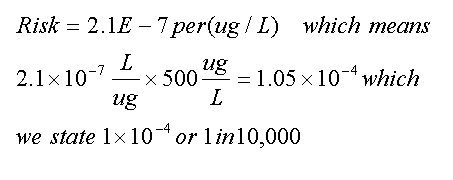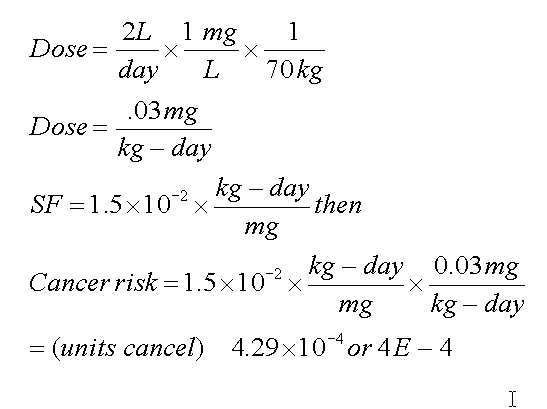
***Q. In order to do the first part of the homework I assumed that the equations
introduced in Sub module 8a are applicable to RfD and RfC, is this correct?
Can inhalation and oral ingestion be treated the same as far as HQ?
A. Yes, they are added.
***Q. For the significant figures of the HQ you say they are not expressed
greater than whole number precision, but isn't it more accurate to say one significant
figure since most RfD, RfC, and HQ's are smaller than one.
A. Yes, one significant figure.
***Q. Are there any know combined effects that are synergistic? That seems
to be something that should be noted whenever possible since it could be very
dangerous. If there was a synergistic combined effect, how would that be noted?
Or wouldn't it? And What if various chemicals are present which react with each
other to form chemicals, which are either more carcinogenic or less carcinogenic?
How would you calculate the risk then?
A. Excellent question. Many synergistic effects are known. Carbon monoxide and
methylene chloride is one that comes to mind. Most of these are noted at higher
doses. I don't know of any that have been verified at environmentally relevant
doses. If you suspected that two chemicals were a problem, you would do a web
search with the two plus synergy, "combined effects" and such. I don't
remember seeing any of these in IRIS or such. There may be a database of suspected
synergies, but I not aware of it.
***Q. How do you determine the ambient concentration of a contaminant? Would
this be done by modeling or monitoring? Is there a better method than another?
A. Monitoring will give you the exact answer for the concentration at the monitoring
site on the day you did the sampling. Anywhere, anytime other than that, you
have to model or make assumptions.
***Q. Why is the dermal route lacking relevant RfD? Is this because of the difficulty
of tracking how much is absorbed through the skin, etc?
A. Ideally, the research work is done in the order of priorities, the most common
and most hazardous first. Dermal is not nearly as common in environmental settings.
For workplace hazards, where it is known, it is possible to shield the workers
with gloves and so on. In general, small lipophilic molecules are absorbed through
the skin, but most of these are volatile, hence low dermal exposure in the environment.
Unlike laboratory experiments where the chemical is placed directly on the skin,
environmental exposures involves mass transfer between the contaminant from
a soil grain or organic center in the soil, into the skin. This is difficult
to model.
***Q. I got question 10 correct (1 in 10,000), but to be totally honest, I
am not exactly sure HOW I got it correct. Would you please explain the answer?
Actually, it would be helpful if you explained all the answers on this homework
assignment (it would be a good way to reinforce my methods and check for potential
mistakes).
A. From IRIS
Oral Slope Factor -- 7.5E-3 per (mg/kg)/day
Drinking Water Unit Risk -- 2.1E-7 per (ug/L)
Extrapolation Method -- Linearized multistage procedure, extra risk
Drinking Water Concentrations at Specified Risk Levels:
Risk Level Concentration
E-4 (1 in 10,000) 5E+2 ug/L
E-5 (1 in 100,000) 5E+1 ug/L
E-6 (1 in 1,000,000) 5E+0 ug/L
The concentration in water is 500 ug/L, which is 5E+2 ug/L and thus E-4 or 1 in 10,000 as given a few lines above. Or you could get it from the Drinking water unit risk a few more lines above:

***Q. Can a chemical have both an RfC and an RfD? If they can, would the number
be different or the same? Why would they be different?
A. Yes, yes. If the target organ were different than the route of entry, both
RfC and RfD would depend the amount that is absorbed into the blood. Regarding
amount absorbed, the RfC has imbedded assumptions about the amount the subject
breaths and the amount absorbed from the air (a portion of the contaminant may
be exhaled). The RfD has an assumption about the amount absorbed from the GI
tract. These assumptions are a combination of the result of animal exposures
and the use of PBPK models.
***Q. Would there be multiple RfD than for different target organs?
A. Not target organs, but there could be two, one for ingestion and one for
dermal. Also, there can be more than one for ingestion, if there is some known
great difference between short term and chronic exposures.
Q. I really never clearly understood the concept that the risks should be between
10^-4 to 10^-6 to be considered acceptable range. What if the risk is 10^-2,
doesn't that need more attention to be included in the Super fund than a site
having a risk level of 10^-8?
A. I may not have stated that well. Yes, a risk of 10^-2 is 100-fold more hazardous
than a risk of 10^-4.
***Q. The RfD is 6E-2 mg/kg-day
Inhalation Unit Risk -- 6.2E-4 per (ug/cu.m) Note the "per" This is
the same as:

Q. Just double checking-the inhalation and ingestion routes would both use the
RfC to determine the overall HI?
A. Ingestion uses RfD.
***Q. I also don't understand how the slope factor plus the daily intake can
be used to calculate the increased incidence of cancer. Please show me the calculation.
A. The slope factor gives you the increase in cancer incidence for amount presented
(dose) to the lab animals each day per kg of animal. You have to make an assumption
about the daily intake to humans. For drinking water, it is 2 l per day times
the concentration in the water. Also assume that the human weighs 70 kg. The
SF for Benzene (one of them, there are several given) is 1.5 E-2 per mg/kg-day.
What is the increased risk from a chronic daily intake of 1 mg/L?

Q. Once again, as Module 6's homework showed, these numbers are generally very
conservative for the situations they are meant to characterize. However, there
are some assumptions in them that might not extrapolate to all situations. For
instance, assuming 2 L per day may underestimate consumption if the water is
used in cooking and mixing up powdered milk and juices. Is that where site-specific
risk assessments come in to play?
A. Not so much, even site specific usually use these default assumptions. The
probabilistic methods of Module 10 account for some of this.
Q. I though the inventories of the substances on the IRIS site were very informative.
They provided a concise way of summarizing different types of uncertainty. I
especially liked how they used a UF factor of 3 and compared it to data that
they had more or less confidence in.
A. These are made by "the EPA," which is actually a set of contractors
to the EPA that make them originally. Then they are reviewed by a "panel
of experts," many of those are hired from outside the agency.
Q. In IRIS, what is the Drinking Water unit risk used for? How can the concentrations
and specified risk levels be used effectively?
A. Just a quick way of getting an answer, also using the slope factor, or presenting
it to the public, involves integrating the slope factor with your assumptions
regarding inhalation and drinking habits. With the unit risk, those assumptions
are hidden.
Q. I enjoyed reading the article on the leukemia outbreaks in Fallon. It led
me to thinking about a similar situation in Valdez. Valdez being another small
town (~4500 pop.) has had a high number of breast cancer outbreaks in the last
10 years. Some women down there blame the water, some blame Alyeska across the
bay, for releasing a too high quantity of benzene in the air. I know that if
you are down in Valdez on an evening (preferably the city dock) you can very
easily see an orange-ish cloud of something drifting away from the Alyeska operations
area. Who knows? But I wonder if the reason that no one looks into these cases,
more closely, is just because the situation hasn't gotten "bad enough".
Either that or there isn't the money, but you wouldn't think that of Valdez.
A. Alyeska had a team of renown toxicologists survey Valdez and could not find significant exposures. I believe you can get that study in the library, if not ours, the Valdez library. But even toxicologists don't want to breath "orange clouds."